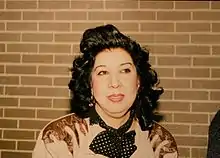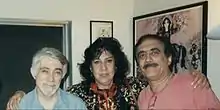Simin Behbahani
Simin Behbahani, her surname also appears as Bihbahani (Persian: سیمین بهبهانی; 20 July 1927 – 19 August 2014) was a prominent Iranian contemporary poet, lyricist and activist. She is known for her poems in a ghazal-style of poetic form. She was an icon of modern Persian poetry, Iranian intelligentsia and literati who affectionately refer to her as the lioness of Iran.[1][2] She was nominated twice for the Nobel Prize in literature, and "received many literary accolades around the world."[3]
Simin Behbahani سیمین بهبهانی | |
|---|---|
 Simin Behbahani in 2007 | |
| Born | Simin Khalili 20 July 1927 |
| Died | 19 August 2014 (aged 87) |
| Burial place | Behesht-e Zahra |
| Nationality | Iranian |
| Other names | Simin Bihbahani |
| Education | University of Tehran |
| Occupation | Poet, lyricist, writer |
| Spouse(s) | Hassan Behbahani (1946–1970, divorced) Manouchehr Koshyar (1971–2002, his death) |
Biography

Simin Behbahani, whose name at birth was Simin Khalili (Persian: سیمین خلیلی)[4] (سيمين خليلی), was the daughter of Abbās Khalili (عباس خلیلی), poet, writer and editor of the Eghdām (Action) newspaper,[5] and Fakhr-e Ozmā Arghun (فخرعظمی ارغون), poet and teacher of the French language.[6] Abbās Khalili (1893–1971) wrote poetry in both Persian and Arabic and translated some 1100 verses of Ferdowsi's Shahnameh into Arabic.[5] Fakhr-e Ozmā Arghun (1898–1966) was one of the progressive women of her time and a member of Kānun-e Nesvān-e Vatan'khāh (Association of Patriotic Women) between 1925 and 1929. When being trained as a midwife, she got accused of writing an article against the school and criticizing it. Due to this false accusation, she was dismissed from the school and that was when she became a member of the communist Tudeh (Masses) Party. In addition to her membership of Hezb-e Democrāt (Democratic Party) and Kānun-e Zanān (Women's Association), she was for a time (1932) Editor of the Āyandeh-ye Iran (Future of Iran) newspaper. She taught French at the secondary schools Nāmus, Dār ol-Mo'allemāt and No'bāvegān in Tehran.[6]
Simin Behbahani started writing poetry at twelve and published her first poem at the age of fourteen. She used the "Char Pareh" style of Nima Yooshij and subsequently turned to ghazal. Behbahani contributed to a historic development by adding theatrical subjects and daily events and conversations to poetry using the ghazal style of poetry. She has expanded the range of the traditional Persian verse forms and has produced some of the most significant works of the Persian literature in the 20th century.
She was President of the Iranian Writers' Association and was nominated for the Nobel Prize in Literature in 1999 and 2002. In 2013, she was awarded the Janus Pannonius Grand Prize for Poetry.[7]
In early March 2010, she could not leave the country due to official prohibitions. As she was about to board a plane to Paris, police detained her and interrogated her "all night long". She was released but without her passport. Her English translator (Farzaneh Milani) expressed surprise at the arrest as detention as Behbahani was then 82 and nearly blind, "we all thought that she was untouchable."[3]
Personal life
She had two marriages, the first was to Hassan Behbahani and it ended in divorce.[1] She had three children from her first marriage, one daughter and two sons.[1] Her second marriage was to Manuchehr Koushyar and it ended when he died in 1984.[1]
Death
Behbahani was hospitalized on 6 August 2014. She remained in coma from 6 August until her death on 19 August 2014, and died in Tehran's Pars Hospital of Pulmonary heart disease at the age of 87.[8] Her funeral, attended by thousands, was held on 22 August in Vahdat Hall, and her body was buried at Behesht-e Zahra.[9]
Works


- The Broken Lute [Seh-tar-e Shekasteh, 1951]
- Footprint [Ja-ye Pa, 1954]
- Chandelier [Chelcheragh, 1955]
- Marble [Marmar 1961]
- Resurrection [Rastakhiz, 1971]
- A Line of Speed and Fire [Khatti ze Sor'at va Atash, 1980]
- Arzhan Plain [Dasht-e Arzhan, 1983]
- Paper Dress [Kaghazin Jameh, 1992]
- A Window of freedom [Yek Daricheh Azadi, 1995]
- Collected Poems [Tehran 2003]
- Maybe It's the Messiah [Shayad ke Masihast, Tehran 2003] Selected Poems, translated by Ali Salami
- A Cup of Sin, Selected poems, translated by Farzaneh Milani and Kaveh Safa
Awards and honours
- 1998 – Human Rights Watch Hellman-Hammet Grant
- 1999 – Carl von Ossietzky Medal
- 2006 – Norwegian Authors' Union Freedom of Expression Prize
- 2009 – mtvU Poet Laureate[10]
- 2013 – Janus Pannonius Poetry Prize, from the Hungarian PEN Club[11][7]
References
- Martin, Douglas (21 August 2014). "Simin Behbahani, Outspoken Iranian Poet, Dies at 87". The New York Times. ISSN 0362-4331. Retrieved 5 June 2019.
- Keshavarz, Fatemeh (13 July 2007). "Banishing the Ghosts of Iran". The Chronicle Review of Higher Education. p. B6.
- Tehran Halts Travel By Poet Called 'Lioness Of Iran' by Mike Shuster, NPR, 17 March 2010
- Behbahani was the last name of her first husband
- Abbās Khalili, Persian Wikipedia.
- Fakhr-e Ozmā Arghun, Persian Wikipedia.
- "Laureates: 2013 Simin Behbahani". Janus Pannonius Grand Prize for Poetry. 2013. Retrieved 5 June 2019.
- "Simin Behbahani, celebrated poet known as the 'lioness of Iran,' dies at 87". The Washington Post. 23 August 2014. Retrieved 5 November 2017.
- Esfandiari, Golnaz (22 August 2014). "Thousands Attend Iranian Poet Behbahani's Funeral". RadioFreeEurope/RadioLiberty. Retrieved 5 November 2017.
- "MTVU – College Music, Activism, Shows and Activities On Campus". MTVU. Archived from the original on 12 November 2009.
- Annamária Apró (26 September 2013). "Janus Pannonius Prize goes to Simin Behbahani". Hungarian Literature Online. Retrieved 30 September 2013.
Further reading
- Chopra, R M, " Eminent Poetesses of Persian ", Iran Society, Kolkata, 2010
External links
| Wikimedia Commons has media related to Simin Behbahani. |
- Biography of Simin Behbahani
- An International Symposium on The Life and Poetry of Simin Behbahani
- A Poet Who 'Never Sold Her Pen or Soul'
- Simin Behbahani Lecture & Book Signing – UCLA
- Simin Behbahani reads poetry at SOAS, University of London, 6 February 2005, YouTube (part 1, part 2).
- Sārā Ommat-e Ali, Simin Behbahani: I am alive, in Persian, Sarmāyeh [Capital Newspaper (Ruz'nāmeh-ye Sarmāyeh). Reprinted in: Association of the Iranian Women (Kānun-e Zanān-e Irani), Wednesday 5 December 2007].
- Shahāb Mirzāi, A Line Made From Swiftness and Fire (Khatti ze Sor'at va Ātash), in Persian, Jadid Online, 2008, [http://www.jadidonline.com/story/17072008/frnk/simin_behbahani.
A slide show of photographs with text spoken by Simin Behbahani, Jadid Online, 2008:] (3 min 56 sec).